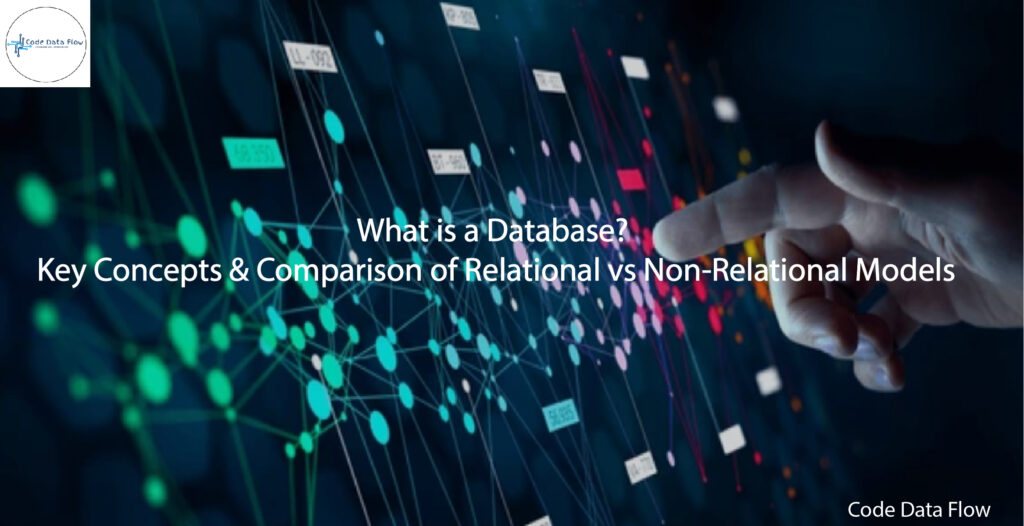
What is a Database? 5 Key Concepts & Comparison of Relational vs Non-Relational Models
Introduction to DataBase:

In today’s data-driven world, understanding what is a database has become essential for developers, analysts, and businesses alike.Databases are at the heart of practically every program you use in this era of data-driven technology. Databases facilitate the effective storage, management, and retrieval of data in a variety of applications, including social networking apps, financial systems, and e-commerce platforms. However, what is a database actually, and how do the various kinds function?
In this blog, you’ll learn:
- What is a database?
- The difference between relational and non-relational databases.
- Which model fits your use case better?
What is a Database? Understanding Its Core Concepts
An orderly collection of data that is simple to access, manage, and update is called a database. It enables programs and people to obtain data using structured interfaces or queries. Imagine it as an intelligent digital file system for all of your information.
Key Concepts of Databases:
Here are some foundational concepts to understand databases better:
- Data: Information stored in the form of text, numbers, images, etc.
- DBMS (Database Management System): Software used to manage and interact with the database (e.g., MySQL, MongoDB).
- Tables / Collections: Structures used to store data in organized formats.
- Queries: Requests to retrieve or modify data.
- Schemas: Define the structure of data — what fields are required, what types of data can be stored, etc.
Relational vs Non-Relational Databases:
Let’s break down the major types of databases and their differences:
Relational Databases (RDBMS):
Structure: Data is stored in tables (rows and columns).
Example Tools: MySQL, PostgreSQL, Oracle, SQLite.
Data Integrity: Strong data integrity via schemas and relationships.
Best For: Structured data with complex relationships (e.g., e-commerce systems, banking).
Pros:
- Supports complex queries using SQL
- Strong consistency
- Mature and widely used
Cons:
- Not ideal for unstructured or rapidly changing data
- Scaling can be difficult (especially horizontally)
Non-Relational Databases (NoSQL):
- Structure: Data is stored in various forms – documents, key-value pairs, graphs, or wide-columns.
- Example Tools: MongoDB (document), Redis (key-value), Cassandra (wide-column), Neo4j (graph).
- Data Integrity: More flexible schemas; ideal for big and unstructured data.
- Best For: Applications with large-scale or real-time data needs (e.g., IoT, social media).
Pros:
- Highly scalable
- Flexible schema design
- Better for storing varied data types
Cons:
- May sacrifice data consistency
- Querying can be less powerful or standardized
Side-by-Side Comparison Table:
| Feature | Relational (SQL) | Non-Relational (NoSQL) |
|---|---|---|
| Data Format | Tables (Rows/Columns) | JSON, Key-Value, Graph |
| Schema | Fixed, predefined | Dynamic/Flexible |
| Scaling | Vertical | Horizontal |
| Query Language | SQL | Varies (Mongo Query, CQL, etc.) |
| Use Case | Structured Data | Unstructured / Big Data |
| Examples | MySQL, PostgreSQL | MongoDB, Redis, Cassandra |
When to Use Which?
Use Relational Databases when your application needs:
- Structured data
- Complex joins and transactions
- Strong consistency
Use Non-Relational Databases when your application needs:
- High scalability and flexibility
- Large or varied data sets
- Rapid development without rigid schemas
Real-World Examples of Relational and Non-Relational Databases:
- Relational Database Example:
An online shopping website like Amazon may use a relational database to manage customer orders, payment details, and product inventory. Each table (like users, orders, products) is connected through unique keys, ensuring consistency and accuracy in transactions.
- Non-Relational Database Example:A social media platform like Instagram or Twitter often stores large volumes of multimedia, user activity, and comments using non-relational databases like MongoDB or Cassandra. These systems allow fast reads/writes and scale well across servers.
Evolution of Databases Over Time:
Over the years, the concept of what a database is has transformed drastically. In the early days, databases were flat files or simple spreadsheets. Then came relational databases in the 1970s, which revolutionized data management. With the explosion of big data and real-time web applications, non-relational (NoSQL) databases have emerged as powerful alternatives for modern developers. Today, many systems even use hybrid approaches, combining the structured reliability of SQL with the flexibility of NoSQL — showcasing just how far databases have come.
What is a Database? Understanding Its Core Concepts
Understanding the difference between relational and non-relational databases helps developers, data scientists, and analysts make the right decisions for their applications. Whether you’re building a social media app or managing hospital records, the choice of database plays a key role in performance and scalability.
So, next time someone asks “What is a database?“, you’ll be ready to explain it like a pro!